Greece › Halkidiki Best Places
By Santorini Dave
See Also
- Where to Stay in Thessaloniki
- Where to Stay in Athens
- Mainland Greece Travel Guide
- Where to Go in Peloponnese
- Best Greek Islands
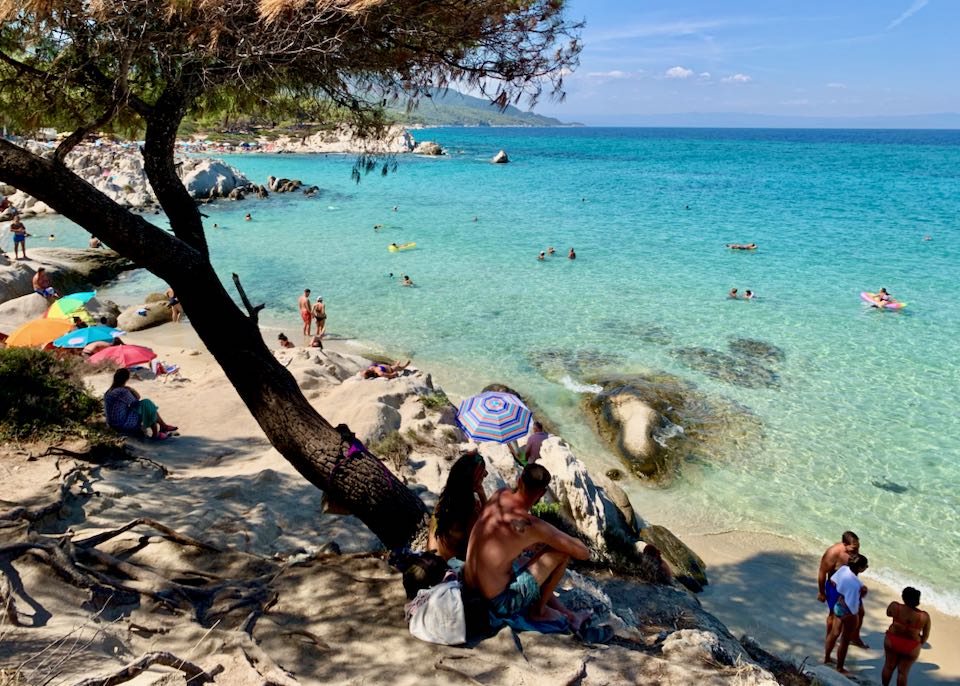
Kavourotrypes Beach on the Sithonia Peninsula in Halkidiki.
What is the Halkidiki?
The Halkidiki is an immensely popular seaside destination in northern Greece. Consisting of four distinct regions (Central Halkidiki, Kassandra, Sithonia, and Athos), three of which extend southeast as “legs” into the Aegean Sea, this region boasts perhaps the greatest number of excellent beaches in the whole of Greece. In July and August, Halkidiki is packed with drive-in tourists from the Balkans and fly-in visitors from the cooler north, all seeking to enjoy some of the truly excellent boutique and luxury hotels on offer. Travelers of a spiritual bent flock year-round to Mount Athos, the area’s monastic republic which has remained virtually unchanged over hundreds of years.
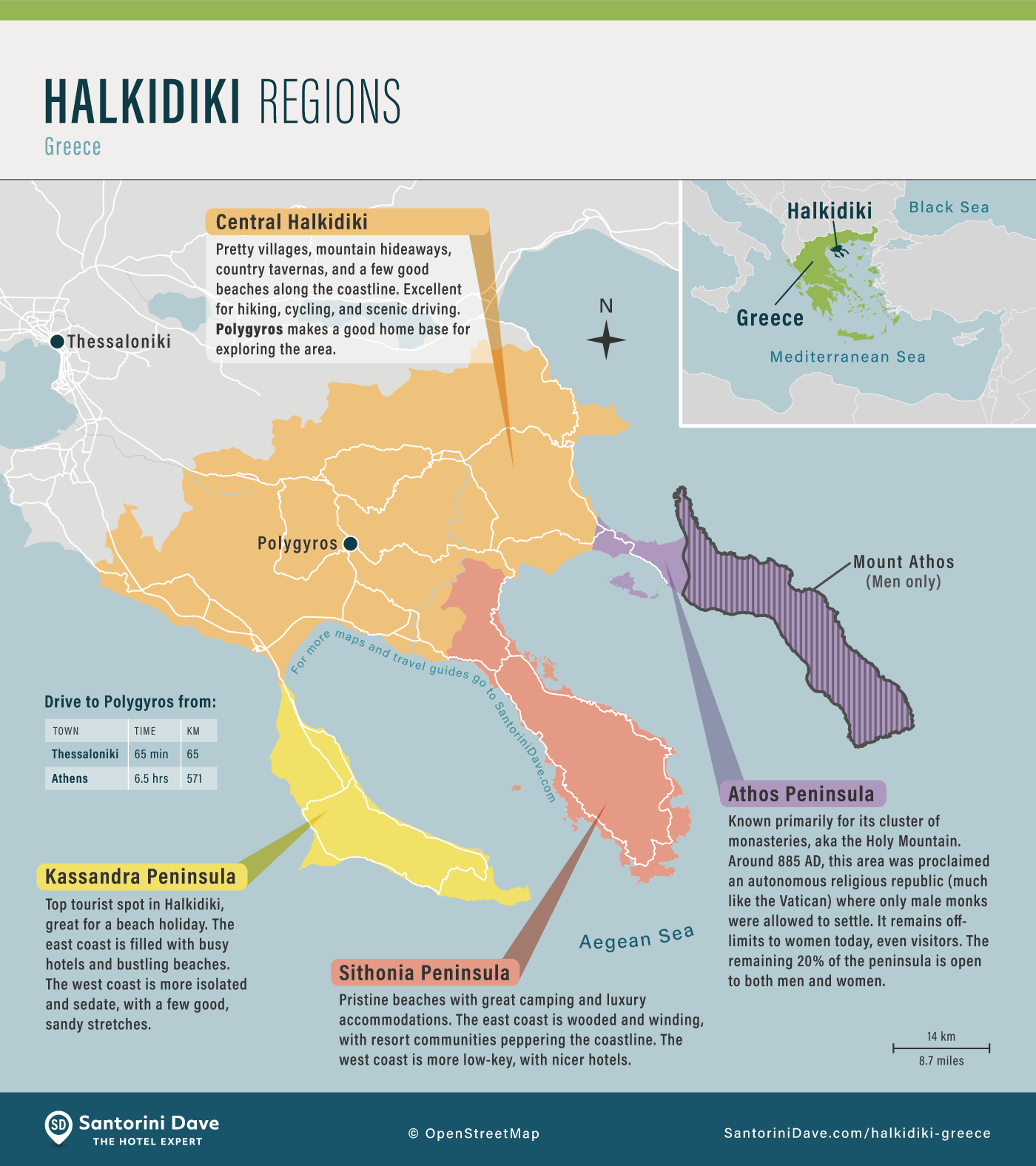
On This Page
- Central Halkidiki
- Kassandra Peninsula (First Leg)
- Sithonia Peninsula (Second Leg)
- Athos Peninsula (Third Leg)
- How to Get to Halkidiki
Halkidiki History
First settled by migrants from Evia (Euboea) in the 8th Century BC and later by another wave from the island of Andros, Halkidiki has a long and fascinating history – and is famous for having been the birthplace of the philosopher Aristotle in 384 BC.
The area was part of the Hellenic Macedonian Empire during the reign of Phillip of Macedon, then was taken by the Romans, and finally the Byzantines. In around 885 AD, the third and eastern leg, the Athos Peninsula, was proclaimed an autonomous religious republic where only male monks were allowed to settle. It has been so ever since – to this day, women still can’t enter even to visit.
More recently, shorelines of the Kassandra and Sithonia peninsulas were allocated to refugees during the population exchange that took place between Turkey and Greece in 1923. This ‘useless land’ became a goldmine when beach tourism took off in Halkidiki in the 1970s – and the descendants of those refugees have been smiling their way to the bank ever since.
Central Halkidiki
About Central Halkidiki
Central Halkidiki is usually regarded as ‘transit territory’ for visitors heading to the attractions of the Peninsulas’ beaches or the monastic quiet of Mount Athos. However, the Center is a destination in its own right and boasts many unsung, pretty villages, mountain hideaways, and rustic rural fare in country tavernas, as well as some excellent hiking, cycling, and scenic driving options. It is also the site of controversial gold mining operations that have driven many locals to distraction. It is home to Halkidiki’s administrative capital, Polygyros, and a few beach enclaves worth considering. A worthwhile archaeological site and an intriguing ancient cave bring up the rear of things to see in this rather underrated part of the region.
Where to Go in Central Halkidiki
- Arnaia is a pretty village that has reinvented itself for tourism and travelers by renovating its traditional Macedonian stone, balconied houses and opening up cozy guesthouses and tavernas with hearty rural menus. Sleepy Arnaia is a total antithesis to the bling of the beach towns and their sometimes crowded, fast life. While Arnaia can be taken in on a slow drive – Sunday after church is a good time to visit, when the locals spill out into the cobbled streets and fill the cafés – is equally enjoyable for a night or two to soak up the sense of the place.
- Mount Cholomontas: This mountain peak forms the bulk of mid-central Halkidiki. Topping out at 1,165 meters, you will be hard-pressed to see the summit unless you hike there; its slopes are covered in a dense carpet of chestnut trees, oaks, and pines. This is prime mountain biking and motorcycle cruising territory, with the pretty village of Taxiarhis making a suitable pit stop for food and fuel. The road between Arnaia and Vrastama is non-stop curves all the way – and is not for those prone to motion sickness.
- Nea Kallikrateia is a bustling seaside resort with a decent beach and everything you would expect from a workaday holiday destination. About 4km further to the east there is a quieter beach scene with casual beach bars, tavernas, and clean sand and sea. Nea Kallikrateia is not on everyone’s travel hit list, and nor does it strive to be. It’s still enormously popular with locals from Thessaloniki, many of whom have holiday homes here.
- Polygyros: The administrative capital of Halkidiki is an agreeable and amenable town, with a cozy center. It makes a good base for Central Halkidiki travel, and because it is lived in all year round it is never too quiet. Excellent boutique accommodation is available as well as some wholesome Greek cuisine. Due to its elevation (560 meters), it is noticeably cooler than the fringes of the peninsulas and snow often falls in the area in winter.
- Psakoudia & Yerakini: The best of the Central Halkidiki beach towns, you could drive past Psakoudia and Yerakini on the main highway and never even notice that they were there. Both beaches are very popular for residents of the inland villages seeking relief from cultivating olives (the mainstay of the region). Psakoudia is a little more than 1.4 km long strip with a nice beach, tavernas, cafés, and some pretty decent accommodation. Of all the typically unnoticed beach communities along the shorelines of the inter-peninsular coasts, Psakoudia is the most attractive. In a similar but lower-key vein is Yerakini, 6.2 km to the west. The beach at Yerakini is good and totally unassuming – and doesn’t get jellyfish that sometimes frequent Psakoudia.
- Ormos Panagias is another beach resort overlooking the big bay (Ormos) of the Virgin (Panagia). The port is cozy and pretty to sit in over an iced ouzo and grilled octopus, but it’s the beach that is the main draw here. When the wind is not from the east, it is perfect. There is some scattered accommodation including a more upmarket option with a pool, Antigoni Beach Hotel.
Central Halkidiki Sightseeing & Activities
- Petralona Cave: First discovered in 1959 by local man Filippos Hatzaridis, this beguiling cave is widely held to be the place where Europe’s oldest known man was discovered – or at least his skull. It has been dated to about 700,000 years ago. The fossils of many animals have also been found in the cave. Located approximately 50km from Thessaloniki and inland from Nea Kallikrateia, it makes for a worthwhile detour. The entry ticket also gives access to the nearby Anthropological Museum.
- Ancient Olynthos: Olynthos was an Ancient Greek city state founded in the 7th century BC and carries a fairly significant history. Archaeology buffs may care to visit the extensive site near the village; it extends over two hills, and the remains demonstrate a fine early example of urban planning. Artifacts found on the site are displayed in the Thessaloniki and Polygyros Archaeological Museums, so the truly historically-bent will want to combine visits to get a fuller picture of the site’s significance.
- Weaving Museum of Arnaia: Traditional weavers still spin their yarn and create carpets and wall hangings following time-honored patterns and methods on very old looms. The woven wall hangings are a tradition of the region, with patterns that have been passed down from generation to generation. A truly fascinating and worthwhile step back in time that maintains links with today. • Map • Phone: +30 237 235 1100
- Break Free Mountain Biking: Take a guided bicycle tour or an invigorating hike in Central Halkidiki. This outfit offers a few tailored tours such as a Cholomontas mountain biking or trekking excursion, plus cycling tours of Sithonia and Kassandra of around 30-40 km in length.
- Artisan handmade soaps: Making soap at home from olive oil, salt, water and caustic soda is a time-honored tradition in this region. It is still made with care in the workshop of artisan Antonis Vasilakis, and you can visit. You’ll find him busy creating at the 6th kilometer of the Polygyros-Yerakini road. Six different aromatic soap products are for sale. • Map • Phone: +30 699 840 1185
Best Hotels in Central Halkidiki
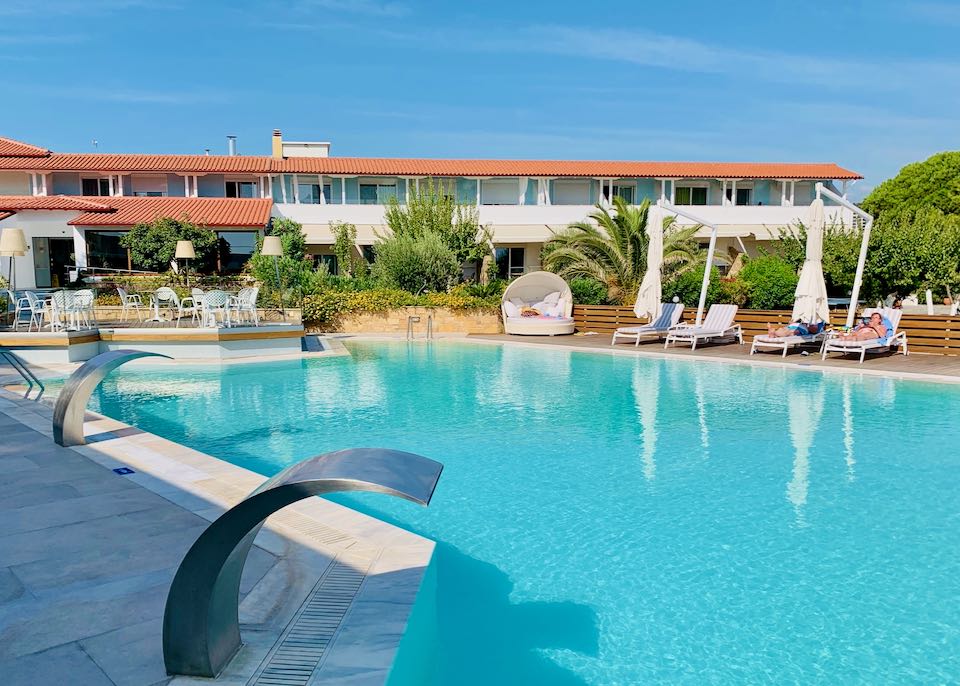
The swimming pool at Antigoni Beach Hotel in Ormos Panagias in Central Halkidiki.
- Antigoni Beach Hotel – Ormos Panagias: Positioned strategically on Ormos Panagias beach, this 4-star hotel offers sophistication and beachside comfort. There’s a cafeteria and restaurant on site, and when it’s too windy to swim at the beach, you can relax in the hotel pool. • Hotel phone: +30 237 503 1809
- Klities Guesthouse – Polygyros: Spacious, stylish, and modern rooms in the middle of Polygyros’ town center. There’s a restaurant and bar on site; family suites sleep five. • Hotel phone: +30 237 102 1001
- Viraggas – Vrastama: For the ultimate quiet getaway (even your phone won’t ring here), meander over to the village of Vrastama and slowly chill in this immaculate old house. Owner Vasilis is an accomplished chef and lays on some fine, tailored meals for guests. • Hotel phone: +30 23710 71429
- Alexandrou Traditional Inn – Arnaia: The 10 cozy, stone and wood-clad rooms this relaxing and historic property within in a restored Macedonia mansion are ideal for a weekend stay. • Hotel phone: +30 237 102 3210
Central Halkidiki Restaurants
- Exi Vryses – Polygyros: Occupying prime garden space in Polygyros, ‘Six Springs” is regarded highly by locals and is perfect for either lunch or dinner. Broad and imaginative menu, perfect for kids. • Map • Phone: +30 237 102 4820
- Marigoula – Polygyros: Cosy and central in Polygyros, with a menu comprising imaginative main dishes and meze dishes for informal shared eating. Try stuffed Florina peppers with anchovy pesto, or chicken rissoles with leak and dill. • Map • Phone: +30 237 102 3171
- Raki me Ellada – Vrastama: You’ll have to make an effort to find this place, 14km east of Polygyros. Rabbit and quail are on the menu but the real stunner is the ‘spetsofaï kapalato,’ a hollowed-out loaf of wholemeal bread stuffed with a rich mix of tomatoes, onions, sausages and other herbs and spice all topped off with the crusty top of the loaf. Delicious. • Map • Phone: +30 237 111 1292
Getting There and Around
Visitors heading to Central Halkidiki will normally take a Sithonia or Athos bus to Polygyros. Disembark at the central bus stop, not at the stop by the hospital. For local destinations surrounding Polygyros, a cab (+30 237 102 2460) might be a solution.
Around Arnaia, the local taxi service (+30 237 202 2523) is a good option for travel within the area.
As with all of Halkidiki – and maybe more so here – your own transport is the best option. Renting a car is the best option. Cycling will involve quite a bit of hill work, so bring taut muscles and a bicycle with good gears.
Kassandra Peninsula (1st leg)
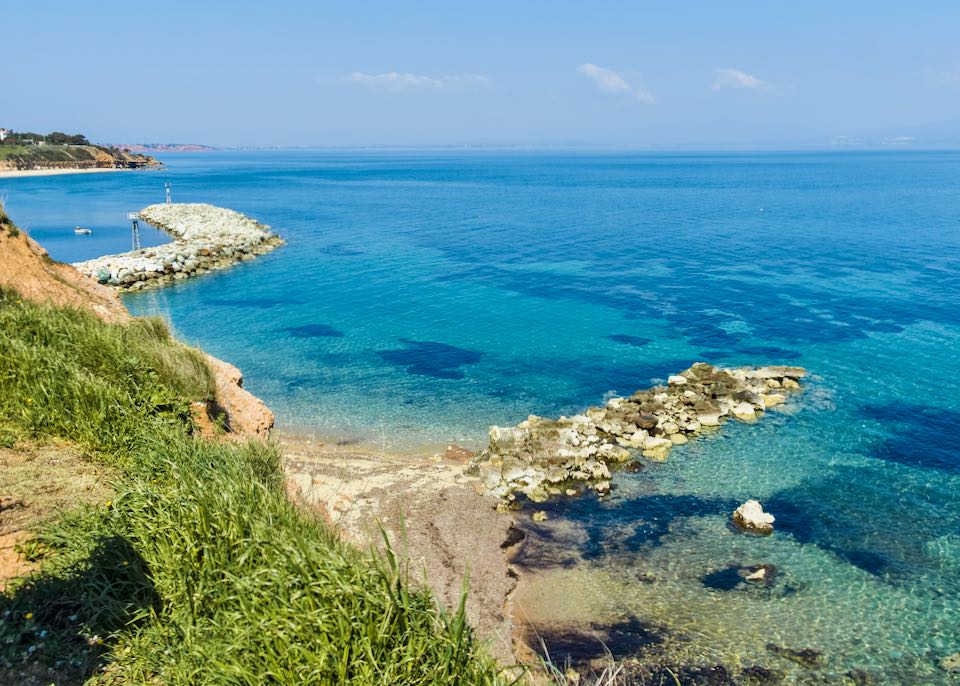
Nea Fokea in Kassandra.
About Kassandra
Kassandra is considered ‘holiday central’ in the Halkidiki tourism stakes. Perhaps because it is closer to Thessaloniki, or maybe because it is easier to get around, either way this peninsula bears the brunt of the annual migration of Halkidiki tourists. Kassandra’s eastern coast has splendid beaches that run almost nonstop from Kallithea in the North to Paliouri in the South. Eastern Kassandra can sometimes feel crowded and raucous, as hotels line the coastline from top to bottom. The western coast of Kassandra is more sedate, but doesn’t have the same quality of beaches as the east side.
Where to Go in Kassandra
- Nea Fokea: The first of the beachside communities that you will encounter as you drive down the east side. It’s a fairly simple affair with a nice pebble beach, a Byzantine tower, and one of the Peninsula’s better restaurants, Massalia. A lot of places in Kassandra were re-incarnations of refugees’ hometowns in Asia Minor and carry the prefix or ‘Nea’ or ‘Neo’ meaning new. This is one of them.
- Afytos: This delightful clifftop village on Kassandra’s eastern coast is unquestioningly the jewel in the peninsula’s crown and tourist flock there. There’s not a lot to it: just charming narrow streets lined with pretty shops, restaurants, and cafes. The star attraction is the clifftop street overlooking the sea. The attractive sand beach is a 10-minute downhill walk.
- Polychrono: Polychrono is an east Kassandra beach town with a narrow, clean, and sandy beach with boat and jet ski rentals, long promenade, and row upon row of shops, cafés, restaurants.
- Pefkohori: Pefkohori is a busy jumble of charming hotels, houses, shops, and restaurants on Kassandra’s southeastern coast – fronted by a long promenade with a narrow beach where visitors can snorkel and sail. Neither subtle nor petite, it is popular with visitors who like bustle and action. Many of Halkidiki’s best hotels are here, including a fine adults-only hotel on the hill (Alia Palace) and a cheery local taverna that holds frequent musical evenings (Villa Elia).
- Loutra: A thermal baths resort tucked away at the southern end of the peninsula’s western side. There is a pleasant pebbled beach with sun loungers and a backdrop of cafés, but folk come mainly for the Agia Paraskevi Thermal Spa and its large salt-water mineral swimming pool. (As of March 2020, the spa is under reconstruction following storm damage and is closed until further notice.)
- Nea Skioni: Nea Skioni is a low-key west coastal town that boasts a sizeable port, an adjacent sandy beach, and enough cafés and restaurants to keep its summer visitors watered and fed. Like most west side communities, it is generally quiet and less intense than its neighbors to the east.
- Possidi: About halfway down Kassandra’s quieter mid-western coast, Posseidi is a small waterfront settlement with a gorgeous kite-shaped beach that juts out into where the Thermaic Gulf meets the Aegean Sea. The beach itself is large and unshaded; Possidi is quiet on the whole and make a good base to read a book or sleep.
- Siviri: West coast Siviri competes hard for the tourist buck with its rivals across the way. It is lower-key, with a long and narrow beach surrounded by ample greenery. Like all west coast beach communities Siviri exists in isolation from its neighbors, so has developed its own identity. There is plenty of accommodation and the usual plethora of places to eat and drink.
- Sane: Sane is the northernmost beach resort on Kassandra’s west coast and also the peninsula’s most isolated. It features flashy resorts and chic boutiques surrounding a circular manufactured marina. The marina’s design gives Sane a distinctly modern look and feel, without the cosiness that is found elsewhere in the region.
Kassandra Beaches, Sightseeing, & Activities
- The eastern coast of Kassandra is essentially a long beach that is decorated so heavily with hotels, shops, and restaurants that sometimes you can’t even see the beach. Some of the best ones feature giant luxury hotels; even the leaner ones support a huge tourism industry. Bathers will generally find clean water here – though it makes sense to swim away from big business. If you’re looking for coziness and a sense of ownership over your plot of beach, you may have to go as far south as Hrousou Beach near Paliouri – or head over to the Sithonia Peninsula.
- Kassandra’s exposed western coast is more isolated, with really good sandy beaches few and farther between. (Grand and sandy Possidi Beach is an obvious exception.) In general, the better beaches here are found along the north-west coast, but you’ll need your own wheels to find what you’re looking for in that area.
- One of the more unusual sights is the Potidea Canal. Running across the neck of Kassandra, it disconnects Kassandra from the mainland (rendering the peninsula, in effect, an island). Blink as you drive over it and you’ve missed it; it’s worth taking the effort to pause at Nea Potidea and having a look.
- Kassandra lends itself well to hill driving. You could spend half a day driving across the center from Sane to Kassandrino, then descend down to either side of the peninsula for lunch.
- The Kassandra Peninsula is all about having a beach holiday and good time, and there are plenty of water-based activities to choose from. If you want to be more active, try cycling. Contact Break Free Mountain Biking Club for details of their Kassandra bicycle tours.
Best Hotels in Kassandra
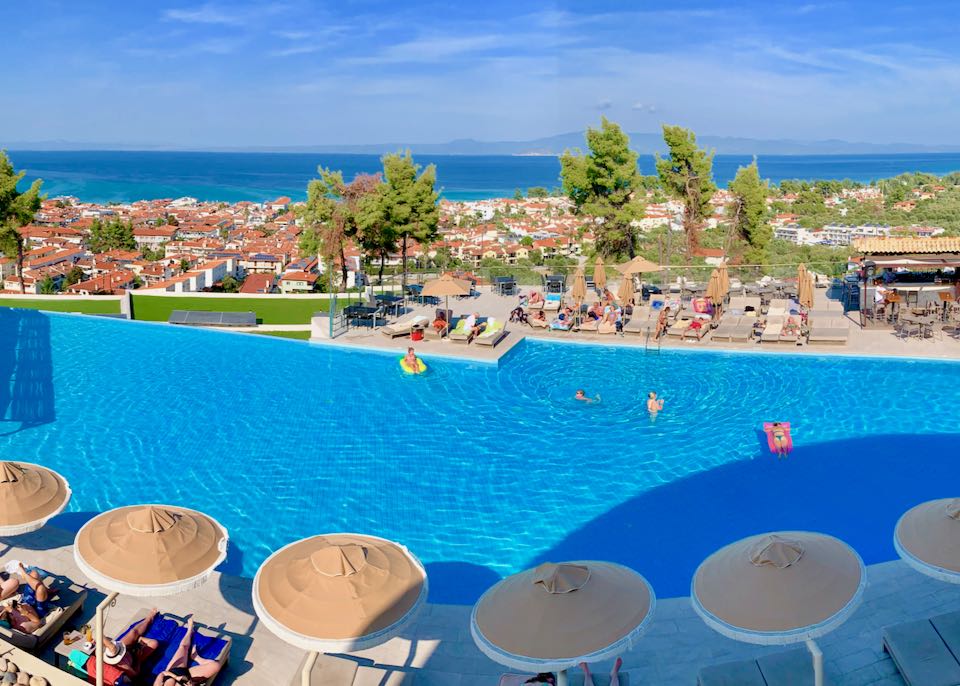
The swimming pool at Alia Palace Hotel in Pefkochori, Kassandra, overlooks the sea.
- Alia Palace Hotel – Pefkochori: A relaxing choice, perched on a hillside overlooking Pefkohori and away from the hustle and bustle below. With its large pool and adjacent bar/restaurant, you get views and space that you won’t find next to the beach. • Hotel phone: +30 237 406 1166
- Art Boutique Hotel – Pefkohori: Swish beach hotel sith seventeen individually decorated and created rooms – all named after famous painters. Pour a glass of wine or just sunbathe on the relaxing and discreet terrace. • Hotel phone: +30 237 406 2931
- Blue Carpet Luxury Suites – Pefkohori: A minimalist, Orient-inspired collection of 27 seaside suites; some suites have private pools. Breakfast, lunch, dine, and wine next to the sea in subtle luxury. • Hotel phone: +30 237 406 2744
- Blue Bay Halkidiki – Afytos: Fantastic hotel overlooking the beach. Pool front suites are great for families. • Hotel phone: +30 2374 091645
Kassandra Restaurants
- Kavouras Sea View – Kallithea: Overlooking the beach at Kallithea this predominantly seafood restaurant gets consistently good reviews from its patrons. Recommended dishes are prawns in pasta (garidomakaronada) or seafood risotto. • Map • Phone: +30 237 402 2900
- Massalia – Nea Fokea: Greek for Marseille (as in France) this is nonetheless a Greek taverna with an avid band of followers. The best deal is ‘mezedes,’ order a few and dive in. Try smoked mackerel with white fish roe salad (taramasalata) and pickles, or smoked aubergine dip. The list is huge. • Map • Phone: +30 237 408 1008
- Taverna Villa Elia – Pefkohori: You’d probably never find this place unless you were told about it – it’s not on any map. Hiding coyly in the back streets next to the church, it’s no nonsense home cooking whatever you order. A whole fish is suggested. Music nights feature frequently. • Phone: +30 237 406 2386
Getting There and Around
- Once again, the bus is the best option for getting around in Kassandra – unless you have independent wheels. It’s 1.5 hours from Thessaloniki’s KTEL Halkidiki to Kallithea, around two hours to Pefkohori and around 2.5 hours to the southern settlements.
- You can easily hire a car locally to get around if you want to avoid the drive from Thessaloniki. Motorbike and scooter rental shops abound.
Sithonia Peninsula (2nd leg)
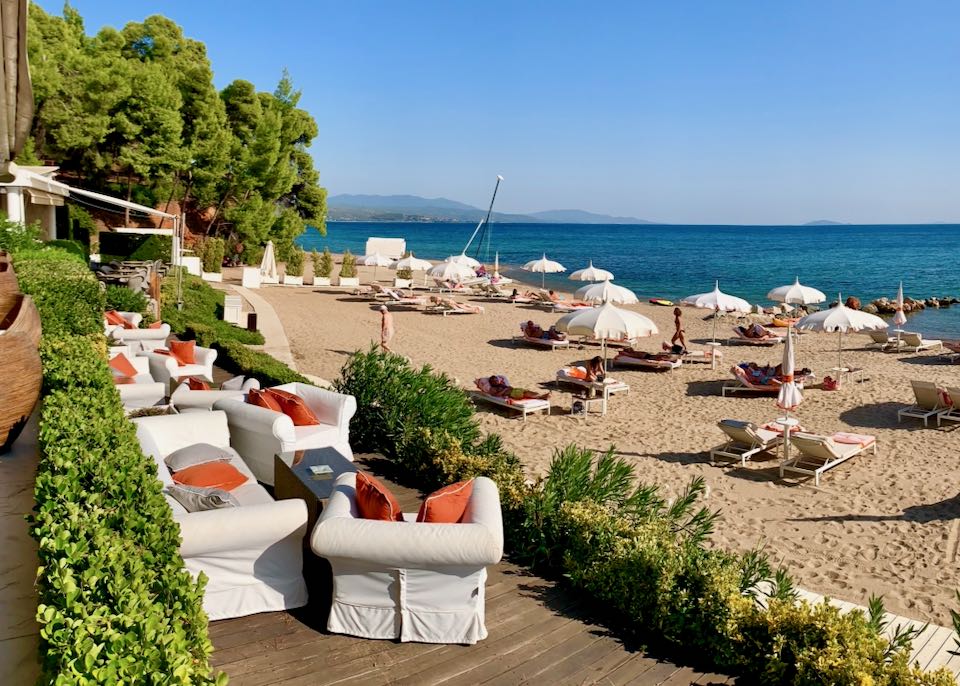
Danai Beach Resort in Nikiti is the best hotel in Sithonia, and it sits right on the golden sand.
About the Sithonia Peninsula
If Kassandra is for travelers looking for a seaside holiday, and Athos is mainly for soul-searchers, Sithonia is for unfettered adventurers looking for the pristine beaches at which to camp or indulge in a bit of couture luxury accommodation. Sithonia has the advantage of two ‘inside’ coastlines, offering more beaches and resorts that are less exposed to the outside weather. Sithonia’s east coast is wooded and winding, with beach communities peppering the coastline. The west coast is more mellow and smooth and is home to Halkidiki’s better hotels and lodgings. Though Sithonia is unreservedly popular, visitors can almost always find a piece of it to call their own for an hour or more.
Where to Go in Sithonia
- Vourvourou: This elongated community on the upper east side looks unremarkable as you drive in from the north; you can hardly see the beach from the road. Real reward awaits, however, for those who head toward the coast here: Karydi Beach is a curved blade of sand between two rocky headlands, backed by trees and populated by an international groups of travelers who revel in the casual ambiance. Bring a picnic and sit in the shade, or choose fine dining nearby. An excellent hotel with prime location completes the movie set.
- Sarti: Sarti is unlike other towns on Sithonia; unapologetically in your face, open, and enthusiastically touristy. You will love Sarti if you love your beach scene big and uncomplicated. The ‘scene’ is one long unshaded (other than by beach umbrellas) waterfront backed by restaurants, cafés and shops. Accommodation can be a bargain here and is undeniably popular with families looking to stretch their Euro, Leu, Dinar, or Dollar.
- Skala Sykias: Skala Sykias is a small community on southern end of the long, crescent, east coast beach of Sykia. While the beach itself is rather exposed and not too inspiring, this little beach and port community at the south end is tidy, neat and just how a hidden-away beach community should be. Three tavernas feed hungry bathers. The pretty village of Sykia is 5.6 km inland where you will find further good eating options.
- Kalamitsi: Twenty years ago, Kalamitsi was the best spot in Halkidiki to get away from it all, with a gorgeous beach and a smattering of tavernas. It still has a gorgeous beach but it has grown exponentially and now getting in with a car is a matter of luck. Probably best to visit early or late in the season. It is worth the effort. Located on the southern end of Sithonia’s east coast.
- Porto Koufo: Porto Koufo is a quaint little southern port protected and hidden from the outside sea to the west. Meaning ‘deaf port’ in Greek – perhaps because you can no longer hear the sea – it is an ideal spot for families with children as the water is shallow and unruffled by waves. The little harbor offers some enticing places to eat.
- Parthenonas: Few people are aware of these ruins in the peninsula’s interior, 6.1 km above Neos Marmaras. Once totally run-down, it is now being carefully put back together stone by stone and the results are impressive. Impressive also is the view at sunset when visitors settle down with a cocktail and watch the sun slip over Kassandra.
- Neos Marmaras: This port community is one of the more established ‘big’ resorts in Sithonia and is home to the expansive (and expensive) Porto Carras Hotel, the pioneer in hotel in Sithonia. You wouldn’t call Neos Marmaras cozy, but it is a lively hub and you can take various excursion ferries across to Kassandra. There is a long beach strip south of the town called Azur Beach where the water is clean and shallow.
- Agia Kyriaki: Agia Kyriaki is a small and isolated village on the west coast of Sithonia that sits on a crescent-shaped beach, backed by shading greenery. Its beach is one of many undeveloped strands that cut into the coastline forming mini bays all the way down to Porto Koufo. You will need your own wheels to explore here and to find your own private place to swim. Not all swimming spots are sandy or serviced, but all are generally serene and quiet.
- Paradeisos: On Sithonia’s west coast, Paradeisos is not quite Paradise (as the name suggests), but a small and unpretentious community with a thin sandy beach packed with loungers. There are some better-than-decent places here to water and feed yourself and it make for a good base if you don’t mind its simple form.
- Elia Nikitis: In this northern part of the west coast, there are many little beach communities that are sequestered and secluded, backed by trees, and keep a very low yet high-quality profile. Elia Nikitis is an almost undefined settlement that stretches from Kovios Beach in the north to Lagomandra Beach in the south, and the unofficial epicenter of the west coast resort areas. The coastline is wooded, with beaches appearing in turn along an attractive coastal road.
- Nikiti: The bustling community of Nikiti is the west coast gateway to Sithonia and one of the few places where you will encounter traffic lights in the peninsula. Not a well-established resort centre in itself, though it is the home to what is perhaps Sithonia’s best hotel and there is a long beach with waters as pristine as anywhere else further down into the peninsula.
Sithonia Beaches, Sightseeing, & Activities
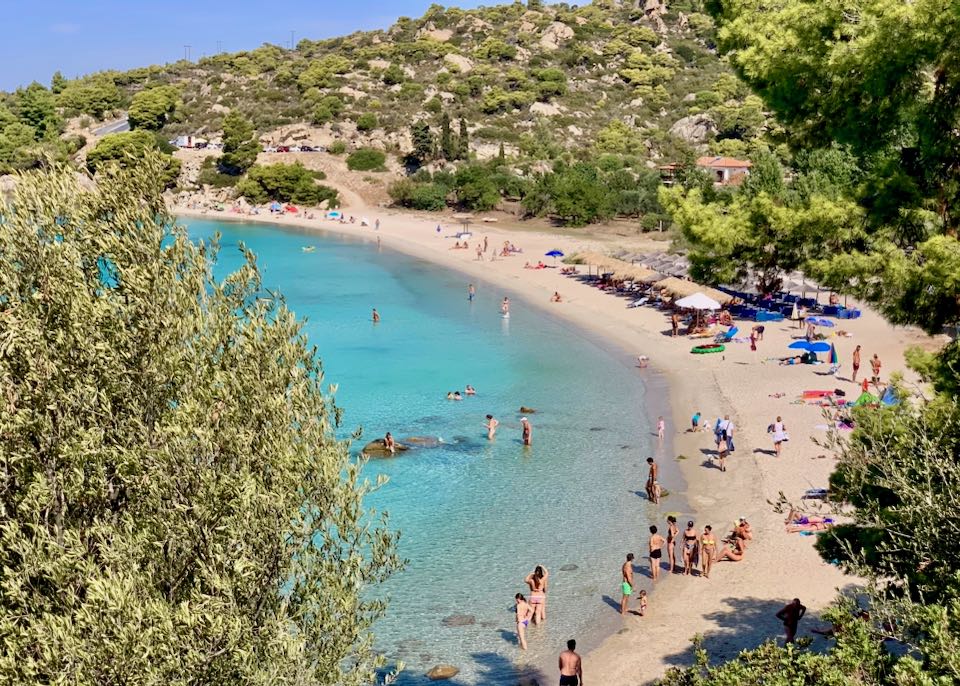
Kovios Beach in Sithonia.
The sights to see on Sithonia are mainly the beaches themselves. Here is a list of the more well-known ones, divided as described above into west side and east side beaches.
- Starting down the east side of the peninsula, first up is Ormos Panagias, situatuated right on the border of Sithonia and Central Halkidiki (and covered in the Central Halkidiki section of this post). The community of Vourvourou is essentially Karydi Beach, an enclosed bay that can get quite crowded in summer but is so very pretty, with lots of shade.
- Further south the next major stop is the more recently developed Manasú Beach (known in the past as Oneirou Beach), home to a private luxury camping site and a modern restaurant, bar, and shopping facility. Don’t let the guys manning the barrier stop you from accessing the public carpark; you can go through at no cost and utilize the Manasú facility. The public beach area and facilities here are excellent.
- Further south you will hit Kavourotrypes (“crab holes”) Beach a funky, hippy-like setting with a series of little bays surrounded by smooth rocks. Rough and ready cantinas serve food and drink underneath the shading trees.
- Skipping Sarti and Sykia beaches (already described above), Skala Sykias is good but not as excellent as the beach at Kalamitsi at the southern tip of the peninsula, which is now feeling the pinch from a spot of over-popularity.
- Coming up the west side, aside from the aforementioned southwest isolated beaches, noteworthy beaches include Lagomandra Beach with handy restaurant and hotel, Kalogria Beach, and the very tempting Kovios Beach, best reached via a short access road on the south side.
- Agios Ioannis Beach further north up the coast, is exposed and unshaded, with a cozy beach bar scene at the western end.
- Water sports are offered at all the main serviced beaches and camping is very popular in Sithonia with some excellent campsites. The “glampground” Armenistis in Sarti is one of the better ones and is sitiated on another excellent beach.
- There is a scuba diving center in Kalamitsi, Dolphin Diving Center, and another one in Nikiti, Atlantis Diving Center, for serious underwater lovers.
Best Hotels in Sithonia
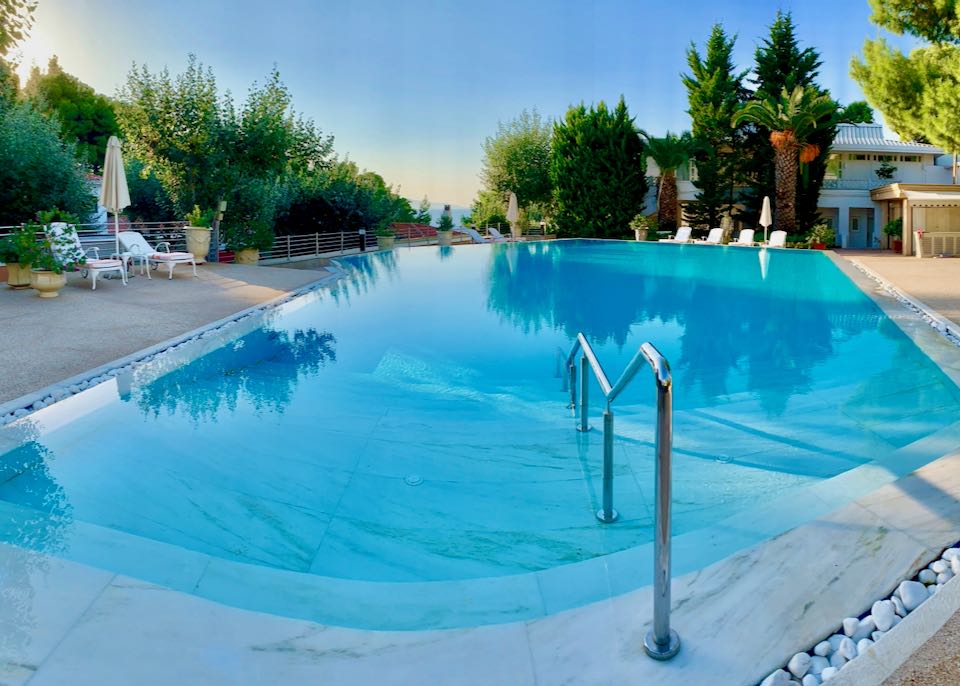
The swimming pool at the Danai Resort in Sithonia.
- Acrotel Athena Pallas – Nikiti: One of a group of hotels under the same flag, this is the jewel and enjoys a good position. The hotel features a pool, but only a short walk will take you to the beach below. Well-appointed rooms and guest services. • Hotel phone: +30 237 508 1410
- Blue Dolphin Hotel – Metamorfosi: A modern well-maintained hotel suitable for families. There is a swimming pool, spa, private beach, and a kids’ playground. It’s a quiet location, but 1km east there is a low-key beach bar and tavern scene. • Hotel phone: +30 237 506 1483
- Danai Beach Resort – Nikiti: Quite possibly the best hotel in the whole of Halkidiki, Danai Beach Resort has and does it all. This discrete yet opulent resort caters to couples and groups who desire total emersion in peace and relaxation. It is small enough to be intimate yet spacious enough to allow privacy. It enjoys a manicured beach, a bar, and a couple of restaurants. The private villas are stunning. Go no further. • Hotel phone: +30 237 502 0400
- Ekies All Senses Resort – Vourvourou: Despite the desultory looking exterior of this beachside resort, the interior is magnificent and decked out in greenery and tropical palms. The hotel is crowned by a delightful beach with large cafe bar and shallow water that’s ideal for families with kids. A very attractive spot and favored for its sheltered position. Sand loungers and umbrellas abound and there are boats for hire. • Hotel phone: +30 237 509 1000
- Thalassokipos Hotel – Vourvourou: A stunningly-located suites-only hotel with brilliant views over the sea below. Set in an olive grove with a steep path down to a small beach, this hotel will suit couples and people seeking utter peace and quiet. There is a little bar and breakfast room, but you will need a car to get to and from, as it is a little isolated. • Hotel phone: +30 237 503 1945
Sithonia Restaurants
- Thalassa Blue Seaside Restaurant – Elia Nikitis: Part of the excellent Lagomandra Hotel & Spa abutting the eponymous beach in Elia Nikitis, the restaurant is one of the best of the places to eat in the area. Professional service, immaculate presentation, and a wide variety of Mediterranean choices. • Map • Phone: +30 237 507 2217
- Limanaki – Skala Sykias: The first of a trio of eateries you will meet upon arrival in Skala Sykias, Limanaki eschews the brash commercialism of its rival up the hill. Limanaki is reserved, simple, and gives good food – seafood of course, plus all the usual staples. • Map • Phone: +30 697 982 7767
- Melia Restaurant – Vourvourou: Set back from Karydi Beach, Melia is a great spot for meze grazing after a good swim. Perhaps try grilled octopus with fava and herbs, or steamed mussels with ouzo, wine, onion and celery. Or how about stuffed squid with fresh tomato and cheese. No need for seconds. • Map • Phone: +30 235 709 1067
- Taverna Giorgakis – Kalamitsi: You can’t get closer to the beach than at this place. You are on the beach. The menu is extensive and covers all tastes. Perhaps this is the place to try that mousakas that you never had. Wash it down with chilled white wine and dash of soda water. • Map • Phone: +30 237 504 1013
- Taverna Tzitzikas – Porto Kuofo: Slap bang in the middle of the little harbor, Tzitzikas (“cicada” in Greek) serves up finely-prepared fish and meat dishes such a stuffed squid, red mullet, or mackerel filets with oil, lemon, and fresh onion rings. The ambiance is just right and the service attentive and quick. • Map • Phone: +30 237 505 1270
Getting There and Around
- The bus is the best unless you have your own wheels. It’s 1.25 hours from Thessaloniki’s KTEL Halkidiki to Nikiti, around 2 hours to Neos Marmaras, 3 hours to Sarti and 3.5 hours to Kalamitsi.
- You can easily hire a car in the main town centers to get around if you want to avoid the drive from Thessaloniki. Motor bike and scooter rental shops are also to be found in major centers.
- Cycling in Sithonia is probably easier on the west side, as there are steeper hills and more pronounced curves on the east coast.
Athos Peninsula (3rd leg)
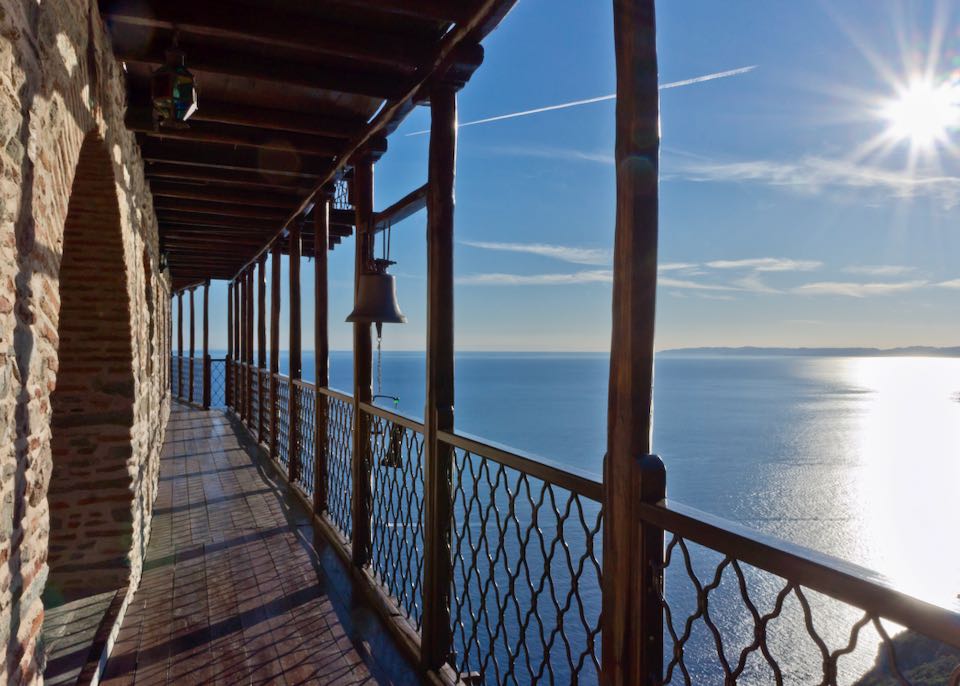
View from a monastery on Mount Athos.
About the Athos Peninsula
The Athos Peninsula is essentially about one destination: the monasteries of Mount Athos, aka the Holy Mountain. The Monastic Republic of the Holy Mountain occupies around 80% of the peninsula, leaving just a mere 20% of the territory to secular visitors and females; women are not allowed into the Holy Mountain. While the greater majority of the peninsula is off-limits to casual visitors, the remaining slice of secular Athos offer some rare treats that include Halkidiki’s only island and its satellites, a busy and commercialized port, a coastal strip packed full of pricey hotels and a low-key, reasonably-priced beach resort.
Where to Go on the Athos Peninsula
- Ammouliani Island: Athos Peninsula’s very own island floats offshore at the north-western end of the peninsula. It is covered in green vegetation, yet boasts a spectacular sandy beach called Alykes. Settled by Asia Minor refugees over 100 years ago, the community has grown up in a pleasant haphazard kind of way and still feels off the beaten track. There are fine places to eat and good accommodation possibilities. Off the southern tip of Ammouliani are a scattering of islets known as Drenia, one of which has a bar and seasonal taverna. Drenia is reached by excursion boats from Ouranoupoli. Ammouliani is reached by ferry from the tiny mainland port of Trypiti, with boats leaving several times a day. For more details visit the island’s website.
- Ierissos: You might miss Ierissos in your hurry to get to Ouranoupoli as the main highway misses its best attraction: its pristine and exceptionally clean beach. The village is a year-round settlement not totally dependent on tourism. It sports a lengthy promenade, a scattering of fine restaurants and cafés, supermarkets, gas stations and an undeniably pleasant ambiance. You could take a seaside apartment here for a week and be entirely happy. Ierissos is not known to the larger world as a resort, but it is happy to proudly wear its moniker as a family destination. Ierissos is also an alternative departure point for monasteries on the eastern side of Mount Athos.
- Mount Athos: Men come here for various reasons: out of curiosity, to feed their soul, to enjoy walking/hiking, to talk to fellow men of the Orthodox cloth, or maybe to seek a temporary alternative to the fast, secular, life on the other side of the border. Mount Athos allows in only 100 Orthodox and 10 non-Orthodox men daily, so getting in requires some planning. Women can get a distant taste of the monastic republic by taking a cruise along the coast or by peering into Athos at a land border point about a 15-minute drive south of Ouranoupoli, where a locked fence and gate firmly deny legal entry to anyone into the Republic. There’s a nearby beach by way of compensation. Plan at least six months ahead if you intend to visit. Guide to Visiting Mount Athos.
- Ouranoupoli: This is the secular capital of Athos: the port, the place to buy religious paraphernalia, the place to hang out over a cold beer and people-watch, and where to get your permit to Mount Athos. While there are hotels and restaurants here in town, the main hotel strip spills northwards along the coast towards Trypiti and enjoys some fine beach scenes. Ouranoupoli (“Heaven City” in Greek) is the end of the line for buses to Athos. From here on, it’s all by sea.
Athos Peninsula Sightseeing, Beaches, & Activities
- Pyrgos Prosforeiou (Ouranoupoli Tower) is an unmistakable edifice in the port of Ouranoupoli. Built in the 14th Century it has served various purposes its primary purpose being to protect the agricultural holdings of the Vatopedi Monastery. In more recent times it was the home of refugee advocates Joyce and Sydney Loch who lovingly kept the tower in habitable condition. Since their passing it has been renovated and is open to the public to explore.
- Xerxes Canal: Persian warrior Xerxes I, during his onslaught of the Hellenic mainland, decided to build a canal across the narrow neck of the Athos Peninsula between Nea Roda and Trypiti. It was completed in 480 BC, and served to allow his fleet to avoid the stormy passage around the tip of the peninsula. The canal was allegedly used once and abandoned; while nothing obvious remains to this day – other than an historical marker – visitors can easily see why a canal was a no-brainer. It’s barely 2 km from one side to the other.
- The inside (western) strip of beaches and those on Ammouliani and Drenia are the most protected from the weather and can usually be guaranteed to be calm. They are frequented by the many crowds of tourists in the narrow hotel strip. The most user-friendly beach here is about 2 km south of Trypiti as you drive to Ouranoupoli. It has a low-key and tree-shaded beach bar and is typically locatable by the haphazardly parked cars along the road. The beach at Ierissos is excellent (wind permitting), as is the one at Nea Roda – also on the eastern side.
- Traditional wooden boatbuilding can be spotted on the Nea Roda road just outside Ierissos. It’s not on a big scale but there are not many places where you can still see wooden boats being built by hand.
- Cheese lovers should make a mooline for the Stathoris Dairy where a wonderful range of cheeses and dairy products are crafted with care and tradition. Try olive oil cheese with oregano, ‘mikrasiatiko’ with hot pepper, and more. Located 2.1 km south west of Ierissos on the Gomati road. • Map • Phone: +30 237 702 2603
- While it seems unlikely, you can actually climb Mount Athos. You must be male, and you will need the normal Holy Mountain permit to get into Mount Athos, but it is doable and enticing. You can walk it in one day, or climb it using a more technical climbing route. While not one of the more familiar climbing destinations in Europe, it has that ‘I did it’ appeal for spiritually-adventurous mountaineers.
Best Hotels in the Athos Peninsula
- Akrathos Beach Hotel – Ouranoupoli: Just short of Ouranoupoli, the Akrathos resort is an up-market hotel with a wide range of comforts. A walkway and bridge connects the hotel to a splendid beach. • Hotel phone: +30 237 707 1100
- Eagles Villas – Ouranoupoli: Luxury and comfort on a hill with a view, Eagles Villas is for discerning families and couples. Comprising 42 luxury villas, this stunning property is the best in the area. • Hotel phone: +30 237 704 0050
- GKEAA Boutique Hotel – Ierissos: In understated Ierissos, this hotel offers quiet comfort close to the beach in a pleasant part of town. Excellent personalized service and finely furnished rooms are the trademarks here. • Hotel phone: +30 237 702 2533
- Agionissi Resort – Ammouliani: Set like an amphitheater on a hillside overlooking the beach, this resort is the best place to stay on Ammouliani. Sixty-nine rooms from singles to apartments; all well-equipped. • Hotel phone: +30 237 705 1102
Athos Peninsula Restaurants
- Athos Taverna – Ierissos: Others may claim the accolades, but Athos Taverna delivers the goods. Low-key, no bells and whistles, just honest food and swift service with a smile. • Map • Phone: +30 237 702 2966
- Kritikos – Ouranoupoli: One of two distinguished and well-established eateries in Ouranoupoli, Kritikos is excellent for fish. Oysters, mussels and shrimp also feature, as well as local specialities. • Map • Phone: +30 237 707 1222
- Lemoniadis – Ouranoupoli: Hugging the seafront, Lemoniadis offers an assortment of well-prepared fish and meat dishes. Service is swift and efficient and the ambiance is just perfect for a lazy lunch or dinner. • Map • Phone: +30 237 707 1355
- Taverna Tzanis – Ammouliani: Abutting the port beach with enticing views over to the Athos Peninsula, Tzanis is probably the best place to dine on Ammouliani. Medium prices with high-quality food. • Map • Phone: +30 237 705 1322
Getting There and Around
All public bus transport options are focused on getting passengers to and from Thessaloniki and Ouranoupoli. Travelers wishing to move on to Sithonia or Kassandra will need to swap buses along the way.
Day trippers to Athos by boat are well served by Athos Sea Cruises. Seven different cruises are offered, varying in length, budget, and style. Boats skirt the coast to the bottom of the peninsula and back, but do not approach too close; don’t expect to see a lot of detail. In addition to Athos, some boats visit Ammouliani, Drenia, and Vourvourou beach on Sithonia.
How to Get to Halkidiki
Flights to Halkidiki
- Thessaloniki is the major hub for flights to and from Halkidiki, and for air domestic and international air connections. Thessaloniki Airport (“Makedonia”) is located 16.5 km southeast of the city center and is connected to the city by the No. 78 bus.
Bus to Halkidiki
- There is no direct local bus service from the Thessaloniki airport to the Halkidiki region; in order to reach Halkidiki by bus, travelers should take a taxi from the airport to the Halkidiki Bus Terminal (located about 10km north of the airport at the 9th kilometer of the Ring Road). It’s about a 12-minute ride. The local bus website is useful for booking online tickets and offers a handy app you can download before your trip, but the site offers no timetable or map, so an online or offline map will be required to plan your itinerary.
- In general, local buses will cover the two the Kassandra and Sithonia peninsulas of Halkidiki as distinct routes; heading down one side and coming back up the other. Buses to the Athos Peninsula terminate at the town of Ouranoupoli; from here, travelers must take ferries down to Mount Athos (the Holy Mountain).
- Intercity buses to and from Thessaloniki use the main Thessaloniki bus station, located 6.2 km west of the city center. The No. 45 local bus departs regularly from Thessaloniki to Halkidiki bus station, making a stop the train station along the way.
Train to Halkidiki
- Thessaloniki is connected by train to northern neighbors like Macedonia and Bulgaria, as well as internally via trains south to Athens and east to the Greek province of Thrace. Thanks to a newly renovated rail track, Athens is reachable from Thessaloniki by train in just 4.5 hours. The number 45 local bus will take you right from the train station to the Halkidiki bus station.
Driving to Halkidiki
- Realistically, Halkidiki is best visited by private transport – either your own, or hired. Driving is easy though some care is required on the main access routes, especially in summer and during long weekend breaks or religious feasts when they can get very fast and busy. The main access route is Route 24 from Thessaloniki to the middle of the Kassandra Peninsula where it abruptly ends near Kallithea (1 hour, 87.7 km). Drivers heading to Sithonia will branch east at Nea Moudania (61 km). Rental cars can be picked up either in Thessaloniki, or the Thessaloniki Airport.
- The roads throughout Halkidiki are generally very good, but can get quite winding once you enter the individual peninsulas. The road from Vrastama to Arnaia via Taxiarhis and Mount Cholomontas is spectacularly winding through thick forests, and makes for a great motorcycle cruise (See Central Halkidiki).
About Santorini Dave